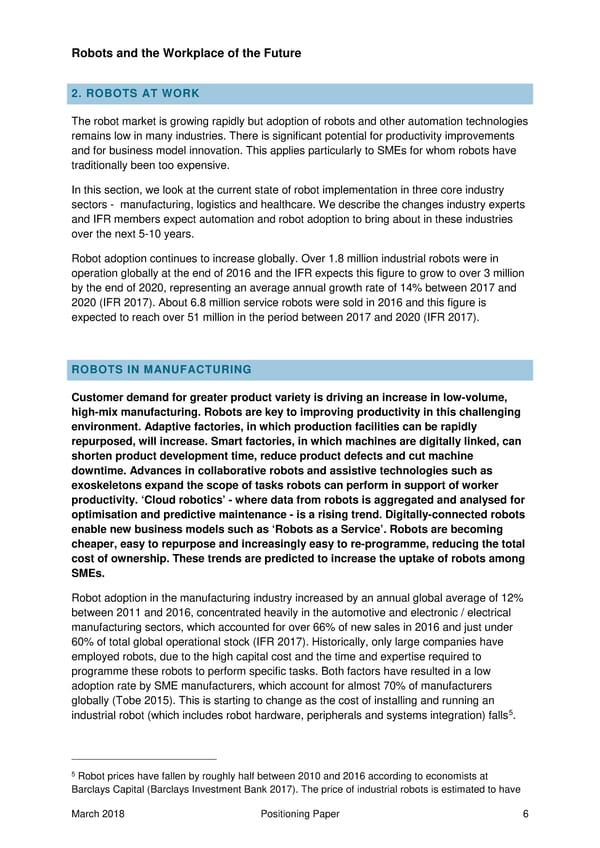Robots and the Workplace of the Future 2. ROBOTS AT WORK The robot market is growing rapidly but adoption of robots and other automation technologies remains low in many industries. There is significant potential for productivity improvements and for business model innovation. This applies particularly to SMEs for whom robots have traditionally been too expensive. In this section, we look at the current state of robot implementation in three core industry sectors - manufacturing, logistics and healthcare. We describe the changes industry experts and IFR members expect automation and robot adoption to bring about in these industries over the next 5-10 years. Robot adoption continues to increase globally. Over 1.8 million industrial robots were in operation globally at the end of 2016 and the IFR expects this figure to grow to over 3 million by the end of 2020, representing an average annual growth rate of 14% between 2017 and 2020 (IFR 2017). About 6.8 million service robots were sold in 2016 and this figure is expected to reach over 51 million in the period between 2017 and 2020 (IFR 2017). ROBOTS IN MANUFACTURING Customer demand for greater product variety is driving an increase in low-volume, high-mix manufacturing. Robots are key to improving productivity in this challenging environment. Adaptive factories, in which production facilities can be rapidly repurposed, will increase. Smart factories, in which machines are digitally linked, can shorten product development time, reduce product defects and cut machine downtime. Advances in collaborative robots and assistive technologies such as exoskeletons expand the scope of tasks robots can perform in support of worker productivity. ‘Cloud robotics’ - where data from robots is aggregated and analysed for optimisation and predictive maintenance - is a rising trend. Digitally-connected robots enable new business models such as ‘Robots as a Service’. Robots are becoming cheaper, easy to repurpose and increasingly easy to re-programme, reducing the total cost of ownership. These trends are predicted to increase the uptake of robots among SMEs. Robot adoption in the manufacturing industry increased by an annual global average of 12% between 2011 and 2016, concentrated heavily in the automotive and electronic / electrical manufacturing sectors, which accounted for over 66% of new sales in 2016 and just under 60% of total global operational stock (IFR 2017). Historically, only large companies have employed robots, due to the high capital cost and the time and expertise required to programme these robots to perform specific tasks. Both factors have resulted in a low adoption rate by SME manufacturers, which account for almost 70% of manufacturers globally (Tobe 2015). This is starting to change as the cost of installing and running an industrial robot (which includes robot hardware, peripherals and systems integration) falls5 . 5 Robot prices have fallen by roughly half between 2010 and 2016 according to economists at Barclays Capital (Barclays Investment Bank 2017). The price of industrial robots is estimated to have March 2018 Positioning Paper 6
 Robots & the Workplace of the Future Page 6 Page 8
Robots & the Workplace of the Future Page 6 Page 8